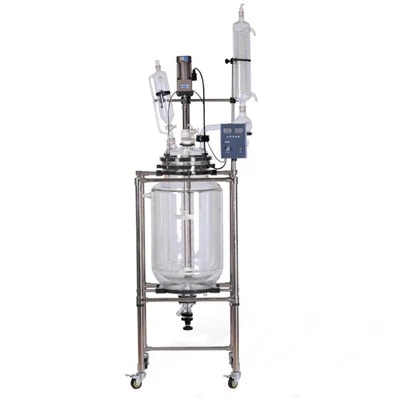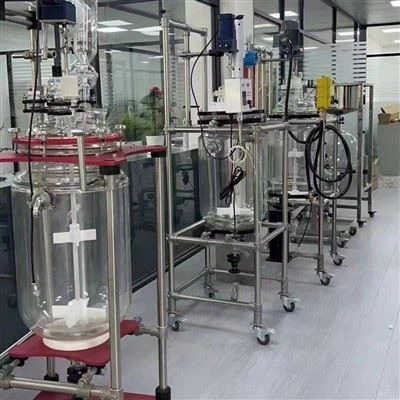How Is Pressure Managed in A Double Jacketed Glass Reactor System?
Jan 01, 2025
Leave a message
Pressure management is a critical aspect of operating a double jacketed glass reactor system efficiently and safely. These specialized vessels are designed to handle various chemical reactions under controlled conditions, making them indispensable in industries ranging from pharmaceuticals to food processing. The pressure within a double jacketed glass reactor is carefully regulated through a combination of advanced engineering features and precise control mechanisms. The reactor's double-walled construction allows for the circulation of heating or cooling fluids in the jacket, which helps maintain optimal reaction temperatures while also contributing to pressure control. Additionally, the system incorporates pressure relief valves, vacuum systems, and sophisticated monitoring equipment to ensure that internal pressure remains within safe operating limits. By effectively managing pressure, operators can optimize reaction conditions, enhance product quality, and maintain a safe working environment in chemical processing facilities.
We provide double jacketed glass reactor, please refer to the following website for detailed specifications and product information.
Product: https://www.achievechem.com/chemical-equipment/jacketed-glass-reactor.html
How Is Pressure Controlled in a Double Jacketed Glass Reactor System?
◆ Pressure Regulation Mechanisms
The pressure control in a double jacketed glass reactor system is achieved through a multifaceted approach. At the heart of this system is a network of sensors and regulators that continuously monitor and adjust the internal pressure. Pressure transmitters provide real-time data to a central control unit, which then orchestrates the operation of various components to maintain the desired pressure levels. One key mechanism is the use of pressure relief valves, which automatically open when the internal pressure exceeds a predetermined threshold, preventing potentially dangerous over-pressurization scenarios.
Another crucial element in pressure management is the reactor's vacuum system. This system can rapidly reduce internal pressure when necessary, allowing for precise control during reactions that require sub-atmospheric conditions. The vacuum system also plays a vital role in the reactor's emptying and cleaning processes, ensuring thorough evacuation of gases and residues between batches.
◆ Temperature-Pressure Relationship Management
In a double jacketed glass reactor, the interplay between temperature and pressure is carefully managed to optimize reaction conditions. The jacket surrounding the reactor vessel circulates thermal fluids that can either heat or cool the contents, directly influencing the internal pressure. Advanced control algorithms take into account the relationship between temperature and pressure, making real-time adjustments to maintain stability. For exothermic reactions that generate heat and potentially increase pressure, the cooling capacity of the jacket is utilized to absorb excess thermal energy and prevent pressure buildup. Conversely, for endothermic reactions, the jacket can supply heat to maintain the required pressure and reaction rate.
Moreover, the system often incorporates a condenser unit, which can be used to manage vapor pressure within the reactor. By controlling the temperature of the condenser, operators can effectively regulate the overall system pressure, allowing for fine-tuned control over reaction conditions and product quality.
What Are the Key Components for Managing Pressure in Double Jacketed Glass Reactors?
◆ Essential Pressure Control EquipmentSeveral critical components work in concert to manage pressure in double jacketed glass reactors. The pressure relief valve stands out as a primary safety feature, designed to open automatically when the internal pressure approaches the reactor's maximum allowable working pressure. This fail-safe mechanism prevents catastrophic failure and protects both personnel and equipment. Equally important is the rupture disk, a one-time-use device that provides an additional layer of overpressure protection by bursting at a specific pressure point, rapidly relieving excess pressure in emergency situations. Pressure sensors and transmitters are integral to the monitoring system, providing continuous feedback to the control unit. These highly sensitive instruments detect even minor pressure fluctuations, allowing for rapid response and adjustment. The control unit, typically a programmable logic controller (PLC) or a distributed control system (DCS), processes this data and manages the entire pressure control ecosystem, including valves, pumps, and heating/cooling systems. |
|
|
|
◆ Auxiliary Systems for Comprehensive Pressure ManagementBeyond the primary pressure control equipment, several auxiliary systems contribute to comprehensive pressure management in double jacketed glass reactors. The inert gas blanketing system is one such component, used to create a non-reactive atmosphere within the reactor headspace. This system not only helps prevent unwanted reactions but also allows for precise pressure control by adjusting the inert gas flow rate. Another crucial auxiliary system is the pressure equalization line, which connects multiple reactors or vessels in a processing train. This line ensures that pressure differentials between connected units remain within safe limits, preventing unexpected material transfer or equipment damage. Additionally, many modern reactor systems incorporate sophisticated data logging and trend analysis tools. These software solutions enable operators to review historical pressure data, identify patterns, and optimize process parameters for enhanced efficiency and safety. |
Advanced Pressure Management Techniques in Double Jacketed Glass Reactors
◆ Adaptive Control Algorithms
The latest advancements in pressure management for double jacketed glass reactors involve the implementation of adaptive control algorithms. These sophisticated software solutions use machine learning techniques to analyze vast amounts of operational data, continuously refining their control strategies. By considering multiple variables simultaneously – such as temperature, stirring speed, and reactant feed rates – these algorithms can predict pressure changes before they occur and take preemptive action to maintain optimal conditions.
Furthermore, adaptive control systems can account for variations in raw materials, environmental conditions, and equipment wear over time. This capability ensures consistent product quality and process efficiency, even as operating conditions evolve. The self-tuning nature of these algorithms also reduces the need for manual intervention, minimizing the risk of human error in pressure management tasks.
◆ Integration with Industry 4.0 Technologies
The integration of double jacketed glass reactors with Industry 4.0 technologies is revolutionizing pressure management in chemical processing. Internet of Things (IoT) sensors provide real-time data on every aspect of reactor operation, including pressure, temperature, and flow rates. This data is then processed using edge computing systems, allowing for rapid decision-making and control adjustments without the need to transmit information to a central server.
Digital twin technology is another innovative approach being applied to pressure management in these reactors. By creating a virtual replica of the physical reactor system, engineers can simulate various operating scenarios, test pressure control strategies, and optimize processes without risking the actual equipment. This capability is particularly valuable for developing new products or scaling up existing processes, as it allows for thorough testing of pressure management protocols before implementation in the physical reactor.
In conclusion, effective pressure management in double jacketed glass reactors is crucial for ensuring safe and efficient chemical processing across various industries. From basic pressure relief valves to advanced adaptive control algorithms and Industry 4.0 integration, a wide array of technologies and techniques are employed to maintain optimal pressure conditions. As the field continues to evolve, we can expect even more sophisticated and reliable pressure management solutions to emerge, further enhancing the capabilities of these versatile reactor systems.
For more information on state-of-the-art double jacketed glass reactors and their pressure management systems, please contact us at sales@achievechem.com.




